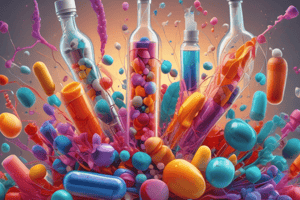Podcast
Questions and Answers
What is the primary advantage of intravenous injection for drug administration?
What is the primary advantage of intravenous injection for drug administration?
- It allows for targeted delivery to specific organs.
- It requires less time for absorption.
- It is the preferred method by drug addicts. (correct)
- It is less painful than other methods.
How do lipid-soluble drugs interact with the blood-brain barrier?
How do lipid-soluble drugs interact with the blood-brain barrier?
- They cannot pass through the barrier.
- They require active transport to enter the CNS.
- They are only absorbed in the intestines.
- They pass through the barrier easily. (correct)
Which route of administration involves the drug being absorbed through the lung tissue?
Which route of administration involves the drug being absorbed through the lung tissue?
- Subcutaneous injection
- Intravenous injection
- Inhalation (correct)
- Oral ingestion
What mechanism of action allows some drugs to act on neural membranes throughout the CNS?
What mechanism of action allows some drugs to act on neural membranes throughout the CNS?
In which type of injection is the drug administered into the fatty tissue just beneath the skin?
In which type of injection is the drug administered into the fatty tissue just beneath the skin?
What is the primary barrier that drugs must overcome to enter the central nervous system (CNS)?
What is the primary barrier that drugs must overcome to enter the central nervous system (CNS)?
What factor makes a drug more likely to pass through the blood-brain barrier?
What factor makes a drug more likely to pass through the blood-brain barrier?
In oral ingestion of drugs, where does the absorption primarily take place?
In oral ingestion of drugs, where does the absorption primarily take place?
What is the process by which a drug is converted from its active form to an inactive form in the body?
What is the process by which a drug is converted from its active form to an inactive form in the body?
Which type of tolerance is characterized by the body becoming more efficient at inactivating a drug?
Which type of tolerance is characterized by the body becoming more efficient at inactivating a drug?
Which statement best describes withdrawal symptoms?
Which statement best describes withdrawal symptoms?
What is a common reason for returning to drug use after detoxification?
What is a common reason for returning to drug use after detoxification?
Which of the following mechanisms does functional tolerance NOT involve?
Which of the following mechanisms does functional tolerance NOT involve?
What is the relationship between tolerance and withdrawal symptoms?
What is the relationship between tolerance and withdrawal symptoms?
Which condition describes the body's decreased sensitivity to a drug after repeated exposure?
Which condition describes the body's decreased sensitivity to a drug after repeated exposure?
What is the effect of drug sensitization?
What is the effect of drug sensitization?
What role does positive reinforcement play in addiction?
What role does positive reinforcement play in addiction?
Which mechanism does NOT contribute to functional tolerance?
Which mechanism does NOT contribute to functional tolerance?
Flashcards are hidden until you start studying
Study Notes
Drug Administration Methods
- Oral Ingestion: Drugs dissolved in stomach fluids, absorbed into the bloodstream, can also be absorbed in the intestine.
- Injection Techniques:
- Subcutaneous Injection: Administered into fatty tissue beneath the skin.
- Intramuscular Injection: Delivered into large muscle groups.
- Intravenous Injection: Injected directly into veins, preferred by drug users.
- Inhalation: Drugs enter lungs, pass through lung tissue into capillaries for rapid absorption.
- Mucous Membrane Absorption: Drugs can be absorbed through membranes in the nose, mouth, and rectum.
Drug Action, Metabolism, and Elimination
- Blood-Brain Barrier: Difficult for many drugs to pass into the CNS; lipid-soluble drugs can cross easily.
- Mechanisms of Action:
- Diffuse Mechanism: No receptor preference, affects neural membranes throughout the CNS.
- Specific Mechanism: Targets specific receptors or neurotransmitter processes.
- Metabolism: Active drugs are converted to inactive forms by liver enzymes; reduces their ability to penetrate the blood-brain barrier.
- Elimination: Inactive metabolites are expelled through sweat, urination, and defecation; a small amount of active drug may remain.
Drug Tolerance, Withdrawal Effects, and Physical Dependence
- Tolerance: Decreased sensitivity to a drug from repeated exposure; requires higher doses for effect.
- Types of Tolerance:
- Metabolic Tolerance: Body inactivates the drug more efficiently; results from liver enzyme changes.
- Functional Tolerance: Changes at the receptor level can lead to downregulation or reduced efficiency of drug response.
- Withdrawal Symptoms: Physiological reactions upon sudden drug cessation, opposite to drug effects; severity influenced by drug type, exposure duration, and elimination speed.
- Drug Sensitization: Increased sensitivity to the drug's effects after initial exposure; may require reduced dosage for the same effect.
Physical Dependence and Positive Incentive Perspectives of Addiction
- Negative Reinforcement: Physical dependence drives drug consumption to avoid unpleasant withdrawal symptoms.
- Positive Incentive Perspective:
- Addiction arises from craving positive drug effects, leading to repeated use beyond withdrawal avoidance.
- Also known as psychological dependence, which works via positive reinforcement.
Studying That Suits You
Use AI to generate personalized quizzes and flashcards to suit your learning preferences.




